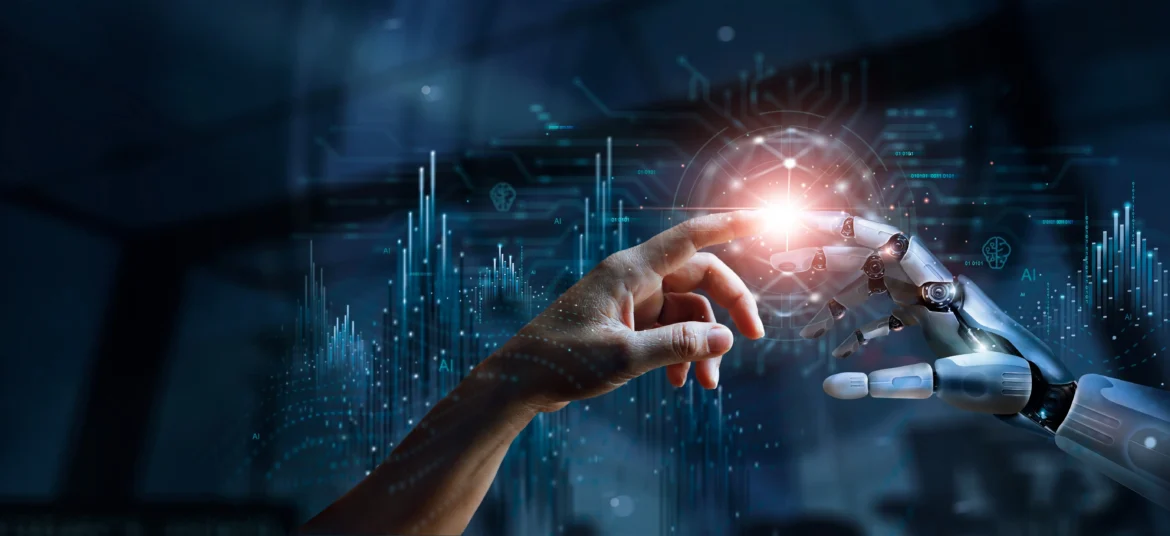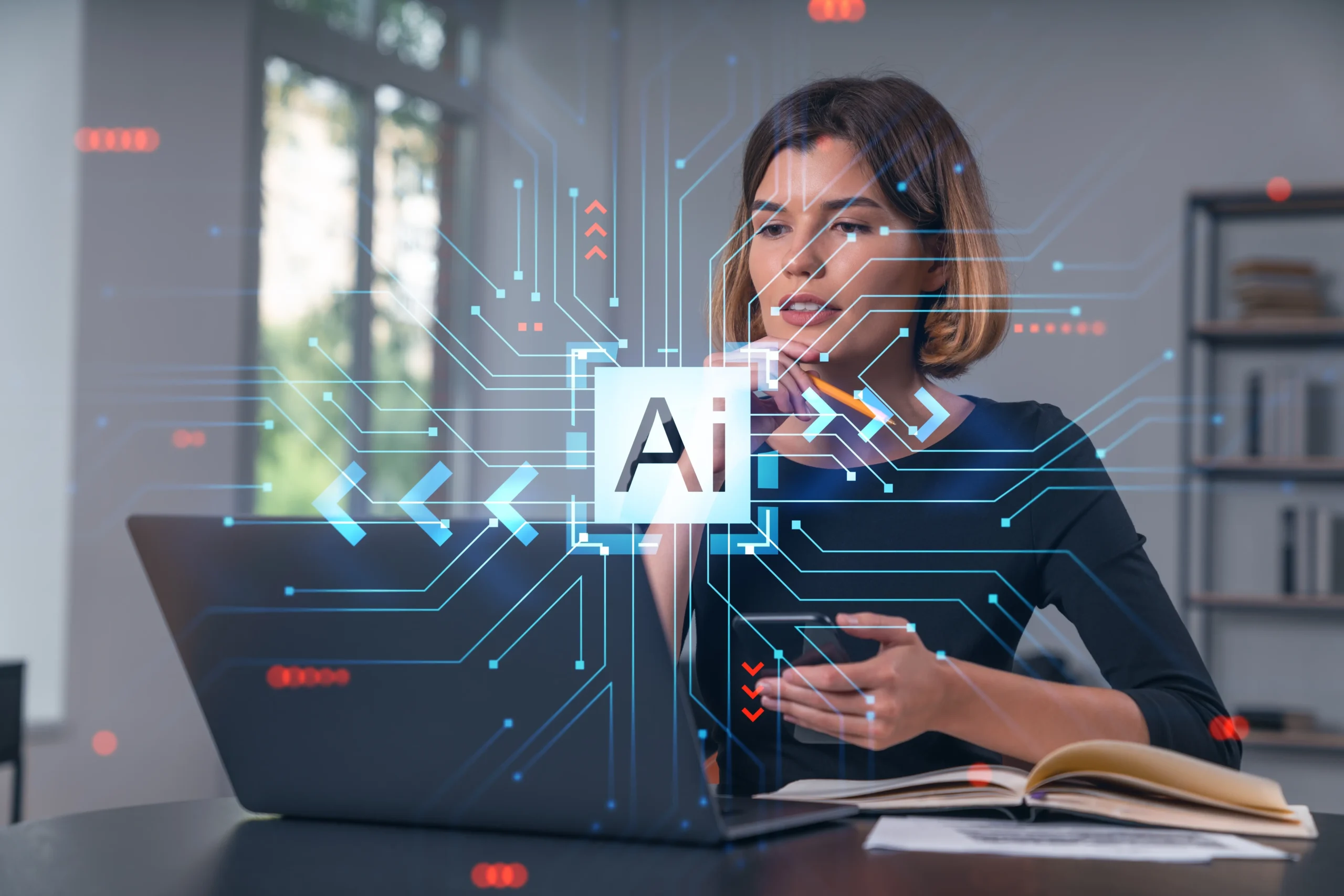What is artificial intelligence?
In simple terms, artificial intelligence (AI) is the ability of machines to perform tasks that normally require human intelligence. These tasks range from pattern recognition to decision making and complex problem solving.
Artificial intelligence is a fascinating field of computer science that seeks to develop systems capable of performing tasks that normally require human intelligence. These systems are designed to learn, reason and make decisions autonomously, using advanced mathematical algorithms and models. Artificial intelligence can be found in a variety of applications, from virtual assistants to autonomous vehicles, radically transforming the way we interact with technology and the world around us.
The history of artificial intelligence dates back to the 1950s, when pioneers such as Alan Turing and John McCarthy laid the theoretical foundations of the field. Since then, artificial intelligence has undergone constant development, fueled by advances in processing power, data storage and improved algorithms. Today, we are witnessing an era in which artificial intelligence is no longer a mere futuristic possibility but a present reality, with applications ranging from medicine to the automotive industry.
One of the most exciting aspects of artificial intelligence is its ability to learn from data and experiences. This process, known as machine learning, allows systems to improve their performance over time without direct human intervention. Machine learning algorithms can classify images, translate languages, predict weather patterns and much more. Artificial intelligence has become essential in the information age, where large amounts of data are constantly being generated, and the ability to extract meaningful information from these data sets is crucial.
The evolution of artificial intelligence has also led to the emergence of concepts such as natural language processing (NLP) and neural networks. PLN allows machines to understand and respond to human language in an increasingly natural way, which has driven the development of virtual assistants and chatbots. Neural networks, on the other hand, are inspired by the structure of the human brain and are central to deep learning, a branch of machine learning that has made significant advances in areas such as image recognition and speech synthesis.

History of Artificial Intelligence
Ancient antecedents: myths and legends suggesting the creation of intelligent machines.
The fascination with artificial intelligence is not a novelty of the modern era. Throughout history, various cultures have woven myths and legends proposing the creation of intelligent machines, long before science and modern technology made these dreams come true. We venture into the ancient myths that explore the idea of artificial intelligence, revealing surprising narratives that have captured the imagination of mankind over the centuries.
The creation of automatons in Greek mythology
In ancient Greece, mythology reveals intriguing stories of the creation of automatons, artificial beings with human characteristics. Such is the case of Talos, a bronze automaton created by Hephaestus, the god of fire and metallurgy. Talos, according to legend, protected the island of Crete, circumnavigating three times a day to avoid intruders.
The golem in the Jewish tradition
Jewish tradition presents the myth of the Golem, a creature made of mud or clay, animated by the word “emet” (אמת), meaning truth in Hebrew, inscribed on its forehead. The Golem, created by a rabbi to protect the Jewish community, highlighted the idea of giving life to inanimate matter.
The Legend of Daedalus and the Minotaur: The Labyrinthine Machine
In Greek mythology, the genius architect Daedalus built the Labyrinth to confine the Minotaur. The complexity of this structure suggests a primitive form of engineering and planning, similar to the creation of an intelligent system designed to fulfill a specific function.
The Myth of the Automaton in Ancient India
In ancient Indian texts, such as the “Yantra Sarvasva”, there are references to the creation of complex automata. These mechanical devices, according to legends, were built to perform specific tasks and exhibit an amazing understanding of engineering for the time.
The creation of homunculi in medieval alchemy
Medieval alchemy introduced the idea of creating homunculi, miniature human beings, through alchemical practices. Although more associated with the creation of life than with artificial intelligence in the modern sense, this conception reflects the ancestral desire to manipulate and control the creation of life forms.
Leonardo da Vinci's automaton
During the Renaissance, Leonardo da Vinci designed an automaton known as the “Mechanical Lion”. This ingenious device, powered by a spring wheel, could walk forward, open its chest to reveal lilies and roar. Although it was not intelligent in the modern sense, it marked a step toward exploring the automation of complex movements.
Mary Shelley's Frankenstein: A Modern Myth
In the 19th century, Mary Shelley contributed to the myth of artificial creation with her novel “Frankenstein”. Although better known for the creation of life than artificial intelligence, the story of Dr. Frankenstein and his monster raises philosophical questions about the responsibility and consequences of bringing artificial entities to life.
The Turkish Chess Player: Illusions of mechanical intelligence
In the 18th century, the “Turkish Chess Player”, an automated chess machine, astonished society. Although later revealed to be a gimmick, this machine fooled people for years, fueling the belief in the possibility of intelligent machines capable of playing chess competently.
The Golem of Prague: A Mystic Protector
In the Jewish tradition, the Prague Golem is another example of artificial creation for protective purposes. According to legend, a rabbi created a Golem to defend the Jewish community. This story highlights the duality of creating machines for benevolent purposes and the possible unintended consequences.
The Trojan Horse: Deceiving with Strategic Engineering
Although not an automaton in the classical sense, the Trojan Horse of Greek mythology presents an ingenious approach to overcoming obstacles. This gigantic wooden construction, used to infiltrate the enemy city, illustrates how engineering can be used as a strategic tool.
The Myth of the Penguin Automaton of Mwindo: An African Adventure
In African mythology, the story of the penguin automaton of Mwindo highlights the creation of an animated machine for the purpose of performing specific tasks. This story highlights the cultural diversity of myths suggesting the creation of artificial entities.

Exploring how AI is integrated into the telecommunications sector.
The convergence of artificial intelligence (AI) and telecommunications has generated a transformative synergy, leading to the creation of smarter networks and more efficient services. Artificial intelligence has found a home at the heart of telecommunications, revolutionizing the way we connect and communicate.
Artificial Intelligence in telecommunications: An Initial Overview
Artificial intelligence, defined as the ability of machines to simulate human thought processes, has become a key element in the telecommunications sector. From automating tasks to improving decision making, artificial intelligence has triggered a paradigm shift.
Operational Efficiency: Optimizing through AI
In the telecommunications world, operational efficiency is key. This is where artificial intelligence comes into play, automating repetitive tasks, reducing manual workload and enabling more efficient resource management. From network monitoring to bandwidth allocation, artificial intelligence optimizes every operation.
FTTH networks: Management and scalability with artificial intelligence
UFINET, at the forefront of FTTH (Fiber to the Home) network implementation, has incorporated artificial intelligence to improve the management and scalability of its networks. Artificial intelligence enables optimized use of splitters for GPON clients, even with low client penetration, ensuring exceptional efficiency on OLT ports.
Co-Location and data centers
Artificial intelligence provides an additional layer of security by proactively detecting threats and optimizing energy resources. UFINET, with a presence in multiple locations, benefits from artificial intelligence to maintain exceptional reliability and security standards.
VSAT and Satellite Services: Quality and Availability Optimization
UFINET’s satellite access network takes advantage of artificial intelligence to optimize the quality and availability of services. With strategically located satellite hubs and more than 1,500 remote terminals in the Americas, artificial intelligence plays a crucial role in ensuring efficient and highly available two-way communication.
Direct Cloud Connectivity: Smart Deployment for Efficient Connections
UFINET’s direct cloud connectivity service establishes unique and direct links through artificial intelligence. This ensures efficient logical connections to more than 126 clouds worldwide, giving customers the flexibility to quickly and efficiently connect to cloud service providers.
Efficiency and Time Reduction with artificial intelligence
UFINET offers additional services such as remote hands, where artificial intelligence plays a key role. From equipment installation to maintenance and troubleshooting, artificial intelligence ensures efficient execution, reducing downtime and improving the customer experience.
Specific Benefits of AI in Telecommunications
Automation of Repetitive Tasks:
Artificial intelligence reduces manual workload and speeds up processes.
Error Reduction:
Minimizes human errors in critical operations.
Service Customization:
Tailors services according to user preferences.
Fast Troubleshooting:
Fast and efficient diagnostics with the help of artificial intelligence.
Ethical and safety challenges in the age of AI
As artificial intelligence becomes more deeply integrated into telecommunications, ethical and security challenges arise. Data protection, transparency and explainability of algorithms become essential to ensure an ethical use of artificial intelligence.
The future of artificial intelligence in telecommunications
As we explore the current applications of artificial intelligence in telecommunications, it is also crucial to look to the future. Emerging trends, such as quantum artificial intelligence and even deeper integration into the 5G network, paint an exciting picture full of possibilities.
Artificial intelligence (AI) has experienced exponential progress in recent decades, deploying astonishing cognitive capabilities that transform the way we interact with technology and, ultimately, the world around us. In detail the cognitive capabilities of artificial intelligence, analyzing how these intelligent machines can learn, reason and solve problems in a manner comparable to, and in some cases, surpassing human capabilities.

Automatic learning
The basis of cognitive abilities
At the heart of the cognitive capabilities of artificial intelligence is machine learning. This branch of artificial intelligence allows machines to learn from past data and experiences to improve their performance in the future. Supervised and unsupervised learning algorithms are used to analyze data, identify patterns and make predictions.
Supervised learning
In supervised learning, the artificial intelligence model is trained with a labeled data set. For example, if provided with labeled images of cats and dogs, the artificial intelligence will learn to recognize the distinguishing characteristics of each and will be able to classify new images accurately.
Unsupervised learning
In unsupervised learning, artificial intelligence works with unlabeled data and must identify patterns and relationships on its own. This approach is essential for data exploration and detection of hidden trends that may not be obvious to the naked eye.
Artificial neural networks
Artificial neural networks are an essential part of the deep learning architecture of artificial intelligence. These structures mimic the way the human brain processes and organizes information. Composed of layers of interconnected nodes, these networks can perform complex tasks such as speech recognition and image processing.
Natural Language Processing: Understanding Speech and Text
Another impressive capability of artificial intelligence is its ability to process and understand natural language. Natural language processing (NLP) models allow machines to interpret and generate text in a manner similar to that of a human being. This applies to chatbots, machine translation and sentiment analysis in social networks.
Pattern recognition: beyond the surface
Pattern recognition is essential to the cognitive capabilities of artificial intelligence. From facial recognition to anomaly identification in large data sets, this capability enables machines to discern meaningful information efficiently.
Decision-making and reasoning: beyond human logic
Artificial intelligence can not only analyze data, but also make decisions and reason about complex problems. This is achieved through advanced algorithms that weight multiple variables and consider different scenarios before reaching a conclusion.
Solving complex problems: Challenging the limits of traditional computing.
Where traditional computing capabilities might fall short, artificial intelligence shines when tackling complex problems. From scientific simulations to logistics route optimization, AI proves its worth by tackling challenges that previously might have been insurmountable.
Speech Recognition and Computer Vision: Interacting with the Physical World
Speech recognition and computer vision capabilities take artificial intelligence beyond traditional human-machine interface limitations. From virtual assistants to advanced surveillance systems, these capabilities enable direct interaction with the physical world.
Ethical implications of AI cognitive capabilities.
As artificial intelligence advances, ethical concerns are also intensifying. The autonomous decision making of artificial intelligence raises questions about accountability and transparency in its actions. Society faces the challenge of establishing solid ethical frameworks to guide the development and use of these advanced technologies.
The future of cognitive AI capabilities
As we move into the future, the cognitive capabilities of artificial intelligence will continue to expand. From quantum artificial intelligence to integration into the Internet of Things (IoT), the next frontier promises even more exciting advances in the way technology understands and responds to the world around it.
Artificial intelligence in its evolutionary history
50s and 60s: Alan Turing and the first steps in AI programming
In the 1950s and 1960s, the world experienced an unprecedented transformation in the field of artificial intelligence (AI). At the epicenter of this revolution was Alan Turing, a visionary scientist and mathematician who laid the foundations for artificial intelligence programming. Turing’s fascinating journey and the milestones that marked the birth of artificial intelligence.
The Pioneering Genius: Alan Turing
At the dawn of the 1950s, Alan Turing, known for his crucial role in cracking Nazi codes during World War II, channeled his genius into the field of artificial intelligence. Turing, with his analytical mind and futuristic vision, became an essential pioneer in the creation of the first intelligent machines.
The Universal Turing Machine: Fundamentals of Programming
In 1950, Turing presented the idea of the “Universal Turing Machine”. This mathematical abstraction became the theoretical basis for computing and computer programming. This concept provided the intellectual tools necessary to approach the creation of machines that could mimic human intelligence.
The Turing test: Can a machine think?
Alan Turing proposed the famous “Turing Test” in 1950 as a criterion for determining whether a machine can exhibit intelligent behavior equivalent to that of a human. This test raised fundamental questions about the nature of intelligence and laid the foundation for the evaluation of artificial intelligence systems.
Symbolic Language Programming: The Birth of AI Programming
During the 1950s, researchers began to develop specific programming languages for artificial intelligence. The LISP (List Processing) language, created by John McCarthy in 1958, pioneered symbolic processing and became a standard for artificial intelligence programming.
The Nimrod Gaming Machine: First steps in practical artificial intelligence
In 1951, Christopher Strachey developed the Nimrod gaming machine, a computer designed to play the strategy game Nim. Although purpose-specific, the Nimrod demonstrated that machines could perform intelligent tasks and laid the groundwork for the development of more advanced systems.
The Church-Turing Theorem: Limits of Computation
At this time, the Church-Turing Theorem, which formalizes the limits of what is computable, was consolidated. This theorem, which reflects the ideas of Alan Turing and Alonzo Church, lays the theoretical foundation for understanding the ability of machines to perform computations and solve problems.
Strategy games and AI game programming
Game programming, especially strategy games such as chess, became a crucial testing ground for artificial intelligence. Researchers such as Claude Shannon explored the application of strategies and algorithms in computer programming to address strategic challenges.
The creation of the first chess program: Turing and A Newell
In 1951, Alan Turing collaborated with David Champernowne in the development of the first chess program. Although this program was rudimentary by modern standards, it marked a milestone in artificial intelligence programming and laid the foundation for future developments in the field of computer chess playing.
The Logic Theorist Project: McCarthy and Automatic Reasoning
In 1956, John McCarthy developed Project Logic Theorist, the first artificial intelligence program to prove mathematical theorems. This milestone showed that machines could perform logical reasoning tasks, paving the way for broader applications of artificial intelligence.
The Dartmouth Conference
The Dartmouth Conference in 1956, organized by John McCarthy, Marvin Minsky, Nathaniel Rochester and Claude Shannon, marked the first time the term “artificial intelligence” was officially used. This event brought together experts to share ideas and lay the groundwork for future research in artificial intelligence.
Challenges and criticisms: The beginning of ethical reflection on AI
As artificial intelligence research progressed, challenges and criticisms also arose. The question of the ethical and social implications of artificial intelligence began to emerge, anticipating debates that continue to this day.
The 1950s and 1960s witnessed an initial flowering in artificial intelligence programming, with Alan Turing leading the way. His vision and contributions laid the foundation for the continued development of intelligent systems and left a lasting legacy in the field of artificial intelligence.
Revival in the 1990s: Time of breakthroughs and sustained development in artificial intelligence
The 1990s marked a significant resurgence in the field of artificial intelligence (AI), with technological advances and sustained developments that redefined the way we interact with technology. The key milestones, innovations and cultural impact of this exciting period, highlighting how artificial intelligence became a transformative force in society.
Neural Networks Renaissance
Neural networks experienced a renaissance. Although they had been explored in previous decades, it was in this period that training algorithms were improved, allowing networks to learn complex patterns. This breakthrough paved the way for more advanced applications, from speech recognition to recommender systems.
Machine Learning and Big Data: A Powerful Alliance
The rise of Big Data and the parallel development of Machine Learning led to significant advances in artificial intelligence. Machines began to process and understand massive amounts of data, enabling more informed decision making and continuous improvement of algorithms.
Development of expert systems
Expert systems, which mimic human reasoning in specific domains, experienced a revival in the 1990s. These systems proved to be effective in areas such as medicine and engineering, providing specialized solutions and consolidating the presence of artificial intelligence in professional environments.
Advances in Natural Language Processing (NLP)
Natural language processing made remarkable advances in the 1990s. Machines began to understand and generate text more effectively, leading to the development of virtual assistants, automatic translators and semantic search systems on the web.
Practical applications in daily life
With the resurgence of artificial intelligence, we are beginning to see practical applications in everyday life. From recommendation engines in entertainment platforms to voice recognition systems in cell phones, artificial intelligence has become increasingly integrated into our daily activities.
Cultural and social impact of artificial intelligence
The resurgence of artificial intelligence not only transformed technology, but also left an indelible mark on culture and society. Films such as “Matrix” and “Blade Runner” explored futuristic themes of artificial intelligence, stimulating reflection and debate on its ethical implications.
Ethical and regulatory challenges
As artificial intelligence gained traction, ethical challenges and the need for clear regulations arose. Data privacy, algorithmic bias, and accountability in automated decision making became critical issues requiring attention and action.
The dot.com bubble and its impact on AI
The boom of technology companies in the “dot-com bubble” era also affected artificial intelligence. Although some companies failed to keep up, this period spurred investment in emerging technologies, including artificial intelligence.

Parallels to the evolution of UFINET: How AI innovations reflect the transformation of UFINET
In the dynamic technology landscape, the evolution of artificial intelligence (AI) has been a key catalyst for innovative companies such as UFINET. The parallels between advances in AI and the transformation of UFINET highlight how these innovations have influenced its development and the telecommunications industry.
Integration of AI in telecommunication infrastructures
UFINET has closely followed the integration of artificial intelligence into telecommunications infrastructures. Process automation, network optimization and the ability to anticipate operational problems are areas where artificial intelligence has contributed to strengthening UFINET’s position in the market.
Neural networks in the optimization of operations
Just as neural networks have revolutionized machine learning, UFINET has incorporated intelligent systems to optimize operations. From network management to proactive problem resolution, the implementation of artificial intelligence-based algorithms has improved UFINET’s operational efficiency.
Machine learning for continuous improvement
UFINET has adopted strategies similar to those of machine learning in its approach to continuous improvement. Real-time data analysis and the ability to dynamically adjust its services reflect the inherent adaptability of machine learning, allowing UFINET to evolve with market demands.
Expert systems for specialized solutions
Just as artificial intelligence has driven expert systems in various fields, UFINET has developed specialized solutions to meet the specific needs of its customers. The ability to offer personalized and tailored services reflects the influence of artificial intelligence on business flexibility.
Digital transformation in the last mile with the use of FTTH
The last mile, a key concept in telecommunications, has been transformed by artificial intelligence and is reflected in UFINET’s adoption of solutions such as Fiber to the Home (FTTH). The delivery of true end-to-end FTTH services demonstrates the convergence of advanced technologies and cutting-edge connectivity services.
Dark Fiber Optics: Full AI-like control
The concept of dark fiber optics, offered by UFINET, is similar to the notion of total control in artificial intelligence. By providing unused fiber optic strands, UFINET enables its customers to have full control of the network, an interesting parallel to the control that artificial intelligence provides in automated decision making.
Efficient interconnection
UFINET’s Co-Location and Data Center services reflect the importance of efficient interconnection, a parallel to the ability of artificial intelligence to effectively connect and analyze data. Presence at neuralgic points shows the synergy between strategic location and operational efficiency, a similarity with artificial intelligence.
VSAT services and direct cloud connectivity: Agile AI-like integration
The satellite access network and direct cloud connectivity offered by UFINET demonstrate agile and efficient integration, paralleling the dynamic nature of artificial intelligence. These services reflect the ability to adapt to diverse connectivity needs, a fundamental characteristic shared with artificial intelligence.
Remote hands and technical support
UFINET’s remote hands and technical support services reflect the importance of fast and accurate assistance, recalling the ability of artificial intelligence to provide solutions and solve problems efficiently.
Adaptability comparable to AI algorithms
UFINET’s Layer 3 network, which provides private and protected IP connectivity, shows adaptability comparable to artificial intelligence algorithms. The ability to integrate diverse technologies and protocols reflects the versatility required for success in both contexts.
A common future
The evolution of UFINET and advances in artificial intelligence share a parallel journey towards innovation and efficiency. The ability to adapt, learn and offer specialized solutions are common denominators that define success in both the telecommunications industry and the field of artificial intelligence.
Benefits of Artificial Intelligence
Operational efficiency: Use of AI to optimize operations and resources.
In the competitive world of business operations, operational efficiency has become a cornerstone for sustainable success. In this context, artificial intelligence (AI) has emerged as a key catalyst, enabling organizations to optimize their operations and resources in ways that previously seemed unimaginable. UFINET has incorporated artificial intelligence to unlock new levels of operational efficiency and how these practices can be a guiding light for other companies.
Operational efficiency in the age of Artificial Intelligence
Operational efficiency refers to a company’s ability to use its resources optimally to achieve maximum results. In the current era, this objective is enhanced by the transformative capabilities of artificial intelligence.
UFINET and the revolution of operational efficiency with AI
UFINET has taken a proactive approach by incorporating artificial intelligence into its daily operations. From network management to resource optimization, AI has enabled UFINET to improve the quality of its services and the profitability of its operations.
Automation of routine processes with AI
One of the key ways in which UFINET has improved its operational efficiency is through the automation of routine processes. Repetitive tasks, such as inventory management and preventive maintenance, are now performed autonomously thanks to artificial intelligence systems, freeing up human resources for more strategic activities.
Network optimization with machine learning algorithms
Network optimization is fundamental in telecommunications, and UFINET has taken this practice to new heights by employing machine learning algorithms. These algorithms can analyze complex patterns in real-time network data, identifying areas for improvement and dynamically adjusting the infrastructure for optimal performance.
Failure prediction and predictive maintenance
Artificial intelligence allows UFINET to foresee potential failures in its infrastructure before they occur. Through predictive analytics, artificial intelligence evaluates historical and current patterns to identify potential problems, allowing UFINET to perform predictive maintenance and avoid costly outages.
Continuous learning and iterative improvement
The unique nature of artificial intelligence is its ability to learn and improve over time. UFINET has integrated this principle into its operations, allowing artificial intelligence systems to adjust their strategies based on past experience, leading to continuous improvement in operational efficiency.
Optimal resource allocation with AI
Efficient resource allocation is essential for any company. Artificial intelligence has enabled UFINET to perform optimal resource allocation, allocating bandwidth, power and personnel precisely according to real-time demand.
Rapid problem solving with AI expert systems
Artificial intelligence-based expert systems have proven valuable to UFINET in rapid problem solving. These systems can diagnose and address operational issues with speed and accuracy, minimizing downtime and improving the customer experience.
Data analysis at scale with AI
Data analysis at scale is a challenging task, but UFINET has overcome this obstacle with the help of artificial intelligence. Artificial intelligence algorithms can process large data sets in real time, providing meaningful information for strategic decision making.
Energy efficiency with AI
UFINET has also applied artificial intelligence to improve energy efficiency. Through real-time monitoring and optimization of energy systems, artificial intelligence has contributed significantly to reducing operating costs and respecting the environment.
Challenges and ethical considerations in the implementation of AI in operations.
Despite the benefits, the implementation of artificial intelligence in operations is not without its challenges and ethical considerations. UFINET has approached these aspects with transparency and responsibility, emphasizing the importance of an ethical approach in the adoption of advanced technologies.
The future of operational efficiency
Operational efficiency will continue to be a key differentiator. Artificial intelligence, with its ability to adapt and evolve, is positioned as a fundamental pillar for the future of operational efficiency, and UFINET is at the forefront of this transformation.
Thus, artificial intelligence has played a crucial role in improving UFINET’s operational efficiency. The intelligent implementation of algorithms, machine learning and predictive analytics has paved the way for a future where operational efficiency and artificial intelligence are intrinsically intertwined, leading the way to a new era of business operations.
Service improvement: How AI improves the quality of the services offered by UFINET.
The constant search for excellence in service quality has led companies to explore new technological frontiers. In this context, artificial intelligence (AI) has emerged as a key driver to elevate and transform the quality of services. UFINET has integrated artificial intelligence to enhance the improvement of its services and how this implementation translates into tangible benefits for customers and the company.
Artificial intelligence and the transformation of services in UFINET
Service quality has become a critical differentiator in the competitive world of telecommunications. UFINET has adopted artificial intelligence as an essential tool to improve its services, marking a milestone in the evolution of the industry.
Personalization of services with recommendation algorithms
Customization is key to meeting individual customer expectations. UFINET uses artificial intelligence-based recommendation algorithms to understand customer behavior patterns and offer personalized services, anticipating their needs.
Optimization of network routes for fast delivery
Fast service delivery is essential in telecommunications. Artificial intelligence enables UFINET to optimize network paths, ensuring faster and more efficient delivery of data and connectivity, significantly improving the customer experience.
Predictive Analytics to Predict Service Problems
The predictive capability of artificial intelligence becomes an invaluable asset. UFINET uses predictive analytics to identify potential service problems before they affect customers, enabling the implementation of preventive solutions and improving service reliability.
Chatbots and virtual assistants for customer service
Efficient customer service is essential. UFINET has implemented artificial intelligence-based chatbots and virtual assistants to provide fast and accurate responses to common queries, improving customer satisfaction and freeing up resources for more complex queries.
Optimization of connection quality
Artificial intelligence also plays a crucial role in optimizing connection quality. UFINET uses machine learning algorithms to dynamically adjust the network and ensure a stable, high-quality connection, even in changing environments.
Customization of offers and service packages
Understanding individual preferences allows UFINET to customize offers and service packages. Artificial intelligence analyzes behavioral data to identify patterns and trends, allowing UFINET to tailor its offerings to the specific needs of each client.
Proactive problem solving with artificial intelligence
Proactive troubleshooting is essential to avoid service interruptions. UFINET uses artificial intelligence-based systems to identify and address potential problems before they impact customers, ensuring seamless continuity.
Continuous evaluation of customer experience
Artificial intelligence enables continuous evaluation of the customer experience. UFINET uses sentiment analysis and automated feedback to better understand customer expectations and perceptions, facilitating continuous service improvement.
Enhanced security with artificial intelligence
Security of services is a critical priority. Artificial intelligence reinforces security at UFINET by proactively detecting threats and implementing preventive measures, ensuring the integrity and confidentiality of customer data.
Operational efficiency and its impact on service quality
Operational efficiency, enhanced by artificial intelligence, has a direct impact on service quality. UFINET has achieved a synergy between efficiency and quality, offering faster, more reliable and personalized services through the intelligent implementation of advanced technologies.
Ethical challenges in the implementation of artificial intelligence in services.
Despite the benefits, the implementation of artificial intelligence in services is not without ethical challenges. UFINET addresses these challenges with transparency and an unwavering commitment to customer data privacy and security.
The future of services
In a landscape where customer expectations are constantly evolving, artificial intelligence is positioned as the catalyst for the future of services. UFINET is at the forefront of this transformation, leading the way to smarter, more agile and customer-centric services.
So artificial intelligence has proven to be an invaluable asset in improving UFINET’s services. From personalization to security, artificial intelligence has elevated the quality of services, positioning UFINET as an innovative leader in the industry. The promising future of services is intrinsically linked to the continuous integration of artificial intelligence and its constantly evolving capabilities.
Artificial Intelligence Tools
Machine Learning: Algorithms that allow machines to learn from data and improve their performance.
Artificial Intelligence (AI) has experienced significant growth thanks to one of its most prominent branches: Machine Learning. This discipline has been instrumental in enabling machines to learn from data and improve their performance, and how UFINET has integrated these technologies into its ongoing evolution.
Machine Learning
At the heart of Artificial Intelligence, Machine Learning is a set of algorithms and techniques that allow machines to learn from data and perform specific tasks without direct human intervention. This learning is based on pattern identification and autonomous decision making as they are exposed to more information.
Types of Machine Learning used by UFINET
UFINET has adopted various forms of Machine Learning to power its services. These include:
Supervised learning
Machine learning: Machines learn from labeled examples, enabling accurate classification of data.
Unsupervised learning
Unsupervised learning: Machines identify patterns in unlabeled data, discovering structures and relationships.
Reinforcement learning
Machine learning: Machines make decisions based on interaction with their environment, continually adjusting to maximize rewards.
Outstanding algorithms used by UFINET
UFINET has implemented a number of Machine Learning algorithms to address specific challenges:
Linear and logistic regression
: To predict behaviors and trends from historical data.
Support Vector Machines (SVM):
For classification and analysis of complex patterns.
Neural networks
Neural networks: Mimic the functioning of the human brain, ideal for complex tasks such as voice or image recognition.
K-Means and hierarchical clustering
Used in unlabeled data analysis to identify groups and relationships.
Practical applications of Machine Learning at UFINET
Network and route optimization:
Machine Learning enables UFINET to dynamically optimize its networks and routes, improving efficiency and service delivery.
Failure prediction and prevention:
Predictive Machine Learning algorithms anticipate potential network failures, allowing UFINET to take preventive measures before outages occur.
Personalization of offers:
UFINET uses Machine Learning to analyze usage patterns and customer behavior, providing personalized offers and services.
Sentiment analysis in customer service:
Machine Learning-based sentiment analysis in customer interactions enables UFINET to improve the quality of its services.
Today, we are immersed in an era where artificial intelligence is no longer a futuristic vision but a palpable reality. Its presence extends to diverse applications, from virtual assistants that simplify our daily interactions to autonomous vehicles that transform mobility. Machine learning capability is one of the most fascinating aspects of artificial intelligence, allowing systems to improve their performance over time as they are exposed to more data and experiences.
Artificial intelligence has become essential in the information age, where large amounts of data are constantly being generated. Its ability to extract meaningful patterns from these data sets has not only revolutionized the way we interact with technology, but has also impacted sectors such as medicine, climate research and more. Artificial intelligence is not only a present reality, but promises to continue to transform and improve our world in even more amazing ways in the future.



